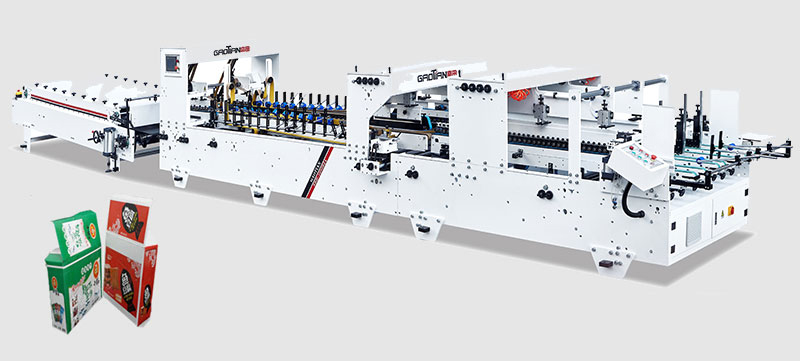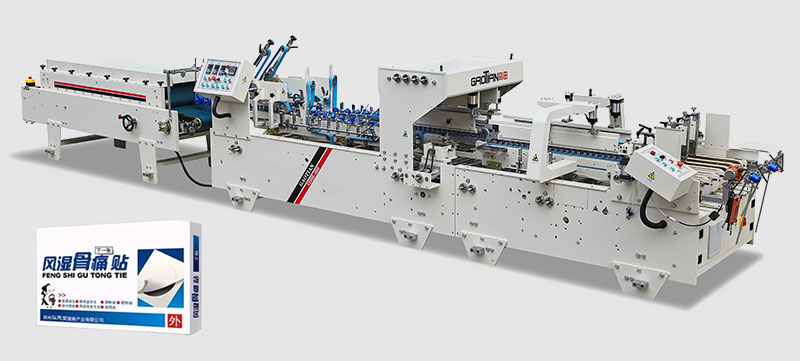Solutions for Improper Gluing of Boxes in Automatic Folder Gluer Machine
In the packaging production process, a common and frustrating issue that operators may encounter with an automatic folder gluer machine is improper gluing of boxes. This problem not only affects the quality of the final product but can also lead to increased production costs due to wasted materials and rework. Understanding the causes and knowing how to address them promptly is crucial for maintaining efficient production.

1. Impact of Improper Gluing
Improperly glued boxes can have far - reaching consequences. From a quality perspective, they may not hold their shape well, which can be a major issue when it comes to protecting the packaged products during storage and transportation. For example, if a box used to ship fragile items is not glued securely, it may collapse during transit, leading to product damage. Economically, it results in a loss of resources. Wasted cardboard, glue, and labor due to re - production of defective boxes can significantly increase the overall cost of production. Additionally, it can cause delays in the delivery of products, potentially harming customer relationships.
2. Analyzing the Causes
2.1 Glue - related Issues
Incorrect Glue Type: Using the wrong type of glue for the cardboard material can be a major cause. Different types of cardboard, such as corrugated or solid - board, require specific glues for optimal adhesion. For instance, a water - based glue might work well for some lightweight cardboard but may not be suitable for heavy - duty corrugated cardboard.
Low Glue Viscosity: If the glue has a low viscosity, it may not spread evenly or adhere properly. This can happen if the glue has been diluted too much or if it has degraded over time. Temperature can also affect glue viscosity; for example, some glues become too thin in high - temperature environments.
Insufficient Glue Application: The automatic folder gluer machine may be set to apply an insufficient amount of glue. This could be due to incorrect settings on the glue - dispensing mechanism or a malfunction in the glue - pump system.
2.2 Machine - related Problems
Clogged Glue Nozzles: Over time, glue residues can build up in the glue nozzles, causing blockages. This restricts the flow of glue, resulting in uneven or insufficient glue application.
Misaligned Gluing Components: The components responsible for applying the glue, such as the glue rollers or applicators, may be misaligned. This can lead to inconsistent glue coverage on the cardboard edges.
Worn - out Gluing Parts: Gluing parts like glue brushes or rollers can wear out after extended use. Worn - out parts may not be able to pick up and transfer the glue effectively, leading to improper gluing.
2.3 Operator and Process - related Factors
Incorrect Machine Settings: Operators may set the machine's speed too high, not allowing enough time for the glue to bond properly. Incorrect pressure settings during the folding and gluing process can also prevent the glue from forming a strong bond.
Dirty or Contaminated Cardboard Surfaces: If the cardboard surfaces are dirty, dusty, or contaminated with oils or other substances, the glue may not adhere well. This can happen if the cardboard is stored in an unclean environment or if it has been handled with dirty hands before being fed into the machine.
2.4 Cardboard - related Reasons
Moisture Content in Cardboard: High moisture content in the cardboard can affect the adhesion of the glue. Moisture can cause the cardboard to expand, and the glue may not be able to penetrate the surface properly. Additionally, some glues may react negatively to moisture, losing their adhesive properties.
Surface Finish of Cardboard: Cardboard with a smooth or coated surface may require a different type of glue or a pre - treatment to ensure proper adhesion. For example, glossy - coated cardboard may be more difficult to glue compared to standard uncoated cardboard.
3. Solutions and Remedies
3.1 Glue - related Solutions
Select the Right Glue: Thoroughly research and choose the appropriate glue for the type of cardboard being used. Consult with glue manufacturers or industry experts if needed.
Check and Adjust Glue Viscosity: Regularly check the glue viscosity using a viscometer. If the viscosity is too low, consider adding a thickening agent or replacing the glue if it has degraded. Maintain the glue at the recommended temperature to ensure optimal viscosity.
Adjust Glue Application Settings: Calibrate the glue - dispensing mechanism to ensure the correct amount of glue is applied. This may involve adjusting the flow rate of the glue - pump or the position of the glue - applying components.
3.2 Machine - related Fixes
Clean Glue Nozzles Regularly: Implement a regular maintenance schedule to clean the glue nozzles. Use appropriate solvents and cleaning tools to remove glue residues and prevent blockages.
Align Gluing Components: Check and realign the gluing components regularly. Use precision measuring tools to ensure accurate alignment.
Replace Worn - out Parts: Keep a stock of replacement parts for the gluing system. When parts show signs of wear, replace them promptly to ensure proper glue application.
3.3 Operator and Process Improvements
Proper Training for Operators: Provide comprehensive training to operators on correct machine settings, including speed, pressure, and glue - application parameters. Ensure they understand the importance of maintaining consistent settings for quality gluing.
Clean Cardboard Handling and Storage: Store cardboard in a clean, dry environment. Ensure that operators handle the cardboard with clean hands or use gloves to prevent contamination.
3.4 Cardboard - specific Solutions
Manage Cardboard Moisture: Control the moisture content of the cardboard by storing it in a climate - controlled environment. If the cardboard is too moist, consider using a drying process before feeding it into the machine.
Pre - treat Cardboard Surfaces: For cardboard with a difficult - to - glue surface, such as glossy - coated cardboard, consider pre - treating the surface with a primer or a surface - roughening process to improve glue adhesion.
4. Prevention is Key
Regular maintenance of the automatic folder gluer machine, proper operator training, and strict quality control of materials are essential preventive measures. Conduct routine inspections of the machine and the gluing process to catch any potential issues early. By implementing these preventive strategies, the likelihood of encountering improper gluing problems can be significantly reduced, leading to more efficient and cost - effective packaging production.
In conclusion, addressing the issue of improper box gluing in an automatic folder gluer machine requires a systematic approach to identify the root causes and implement appropriate solutions. By doing so, businesses can ensure high - quality packaging production and avoid the costly consequences of defective products.





